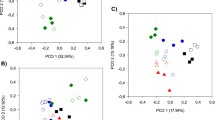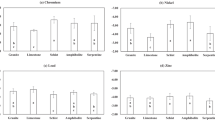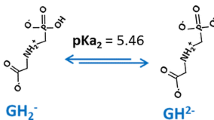Abstract
The large spatial heterogeneity in soil physico-chemical and microbial parameters challenges our ability to predict and model pesticide leaching from agricultural land. Microbial mineralization of pesticides is an important process with respect to pesticide leaching since mineralization is the major process for the complete degradation of pesticides without generation of metabolites. The aim of our study was to determine field-scale variation in the potential for mineralization of the herbicides glyphosate, bromoxyniloctanoate, diflufenican, and bentazone and to investigate whether this variation can be predicted by variations in basic soil parameters. Sixty-five soil samples were sampled from an agricultural, loamy field in Silstrup, Denmark, from a 60 × 165 m rectangular grid. The mineralization potential of the four pesticides was determined using a 96-well microplate 14C-radiorespirometric method. Initial mineralization rates were determined using first-order kinetics for glyphosate and bromoxyniloctanoate and zero-order kinetics for diflufenican and bentazone. The mineralization rates of the four pesticides varied between the different pesticides and the different soil samples, but we could not establish correlations between the pesticide mineralization rates and the measured soil parameters. Only the glyphosate mineralization rates showed slightly increasing mineralization potentials towards the northern area of the field, with increasing clay and decreasing OC contents. The mineralization potentials for glyphosate and bentazone were compared with 9-years leaching data from two horizontal wells 3.5 m below the field. The field-scale leaching patterns, however, could not be explained by the pesticide mineralization data. Instead, field-scale pesticide leaching may have been governed by soil structure and preferential flow events.





Similar content being viewed by others
References
Alexander, M. (1995). How toxic are toxic chemicals in soil. Environmental Science & Technology, 29, 2713–2717.
Badawi, N., Johnsen, A. R., Sorensen, J., & Aamand, J. (2013). Centimeter-scale spatial variability in 2-methyl-4-chlorophenoxyacetic acid mineralization increases with depth in agricultural soil. Journal of Environmental Quality, 42, 683–689.
Bending, G. D., Lincoln, S. D., Sorensen, S. R., Morgan, J. A. W., Aamand, J., & Walker, A. (2003). In-field spatial variability in the degradation of the phenyl-urea herbicide isoproturon is the result of interactions between degradative Sphingomonas spp. and soil pH. Applied and Environmental Microbiology, 69, 827–834.
Bending, G. D., Lincoln, S. D., & Edmondson, R. N. (2006). Spatial variation in the degradation rate of the pesticides isoproturon, azoxystrobin and diflufenican in soil and its relationship with chemical and microbial properties. Environmental Pollution, 139, 279–287.
Benoit, P., Madrigal, I., Preston, C. M., Chenu, C., & Barriuso, E. (2008). Sorption and desorption of non-ionic herbicides onto particulate organic matter from surface soils under different land uses. European Journal of Soil Science, 59, 178–189.
Borggaard, O. K., & Gimsing, A. L. (2008). Fate of glyphosate in soil and the possibility of leaching to ground and surface waters: a review. Pest Management Science, 64, 441–456.
Collins, R. F. (1973). Perfusion studies with bromoxynil octanoate in soil. Pesticide Science, 4, 181–192.
de Jonge, H., de Jonge, L. W., & Jacobsen, O. H. (2000). [C-14]glyphosate transport in undisturbed topsoil columns. Pest Management Science, 56, 909–915.
de Jonge, H., de Jonge, L. W., Jacobsen, O. H., Yamaguchi, T., & Moldrup, P. (2001). Glyphosate sorption in soils of different pH and phosphorus content. Soil Science, 166, 230–238.
de Jonge, L. W., Moldrup, P., & Schjonning, P. (2009). Soil infrastructure, interfaces and translocation processes in inner space (‘soil-it-is’): towards a road map for the constraints and crossroads of soil architecture and biophysical processes. Hydrology and Earth System Sciences, 13, 1485–1502.
Dechesne, A., Badawi, N., Aamand, J., & Smets, B. F. (2014). Fine scale spatial variability of microbial pesticide degradation in soil: scales, controlling factors, and implications. Frontiers in Microbiology, 5.
Dexter, A. R., Richard, G., Arrouays, D., Czyz, E. A., Jolivet, C., & Duval, O. (2008). Complexed organic matter controls soil physical properties. Geoderma, 144, 620–627.
El Sebai, T., Lagacherie, B., Soulas, G., & Martin-Laurent, F. (2007). Spatial variability of isoproturon mineralizing activity within an agricultural field: geostatistical analysis of simple physicochemical and microbiological soil parameters. Environmental Pollution, 145, 680–690.
Fredslund, L., Vinther, F. P., Brinch, U. C., Elsgaard, L., Rosenberg, P., & Jacobsen, C. S. (2008). Spatial variation in 2-methyl-4-chlorophenoxyacetic acid mineralization and sorption in a sandy soil at field. Journal of Environmental Quality, 37, 1918–1928.
Gee, G. W., & Or, D. (2002). Methods of soil analysis. Part 4. Physical methods. Madison: Soil Science Society of America.
Ghafoor, A., Jarvis, N. J., Thierfelder, T., & Stenstrom, J. (2011). Measurements and modeling of pesticide persistence in soil at the catchment scale. Science of the Total Environment, 409, 1900–1908.
Gimsing, A. L., Borggaard, O. K., Jacobsen, O. S., Aamand, J., & Sorensen, J. (2004). Chemical and microbiological soil characteristics controlling glyphosate mineralisation in Danish surface soils. Applied Soil Ecology, 27, 233–242.
Gonod, L. V., Chadoeuf, J., & Chenu, C. (2006). Spatial distribution of microbial 2,4-dichlorophenoxy acetic acid mineralization from field to microhabitat scales. Soil Science Society of America Journal, 70, 64–71.
Hurley, M. A., & Roscoe, M. E. (1983). Automated statistical-analysis of microbial enumeration by dilution series. Journal of Applied Bacteriology, 55, 159–164.
Hybholt, T. K., Aamand, J., & Johnsen, A. R. (2011). Quantification of centimeter-scale spatial variation in PAH, glucose and benzoic acid mineralization and soil organic matter in road-side soil. Environmental Pollution, 159, 1085–1091.
Johnsen, A. R., Hybholt, T. K., Jacobsen, O. S., & Aamand, J. (2009). A radiorespirometric method for measuring mineralization of [C-14]-compounds in a 96-well microplate format. Journal of Microbiological Methods, 79, 114–116.
Kjær, J., Ernsten, V., Jacobsen, O. H., Hansen, N., de Jonge, L. W., & Olsen, P. (2011). Transport modes and pathways of the strongly sorbing pesticides glyphosate and pendimethalin through structured drained soils. Chemosphere, 84, 471–479.
Lecomte, V., Barriuso, E., Bresson, L. M., Koch, C., & Le Bissonnais, Y. (2001). Soil surface structure effect on isoproturon and diflufenican loss in runoff. Journal of Environmental Quality, 30, 2113–2119.
Lindhardt, B., Abildtrup, C., Vosgerau, H., Olsen, P., Torp, S., Iversen, B. V., Jørgensen, J. O., Plauborg, F., Rasmussen, P., & Gravesen, P. (2001). The Danish pesticide leaching assessment programme—site characterization and monitoring design. Copenhagen: Geological Survey of Denmark and Greenland. ISBN: 87-7871-094-4.
McGrath, G. S., Hinz, C., Sivapalan, M., Dressel, J., Putz, T., & Vereecken, H. (2010). Identifying a rainfall event threshold triggering herbicide leaching by preferential flow. Water Resources Research, 46, W02513.
Miljøstyrelsen. (2014). Bekæmpelsesmiddel-statistik 2013. København K: Miljøstyrelsen. ISBN: 978-87-93283-33-6.
Norgaard, T., Moldrup, P., Olsen, P., Vendelboe, A. L., Iversen, B. V., Greve, M. H., Kjaer, J., & de Jonge, L. W. (2012). Comparative mapping of soil physical-chemical and structural parameters at field scale to identify zones of enhanced leaching risk. Journal of Environmental Quality, 42, 271–283.
Norgaard, T., Moldrup, P., Ferre, T. P. A., Olsen, P., Rosenbom, A. E., & de Jonge, L. W. (2014). Leaching of glyphosate and aminomethylphosphonic acid from an agricultural field over a twelve-year period. Vadose Zone Journal, 13. doi: 10.2136/vzj2014.2105.0054.
Nowak, K. M., Miltner, A., Gehre, M., Schaffer, A., & Kastner, M. (2011). Formation and fate of bound residues from microbial biomass during 2,4-D degradation in soil. Environmental Science & Technology, 45, 999–1006.
Paradelo, M., Norgaard, T., Moldrup, P., Ferré, T. P. A., Kumari, K. G. I. D., Arthur, E. & de Jonge, L. W. (2015). Prediction of the glyphosate sorption coefficient across two loamy agricultural fields. Geoderma, Submitted.
Rasmussen, J., Aamand, J., Rosenberg, P., Jacobsen, O. S., & Sørensen, S. R. (2005). Spatial variability in the mineralisation of the phenylurea herbicide linuron within a Danish agricultural field: multivariate correlation to simple soil parameters. Pest Management Science, 61, 829–837.
Rodríguez-Cruz, M. S., Jones, J. E., & Bending, G. D. (2006). Field-scale study of the variability in pesticide biodegradation with soil depth and its relationship with soil characteristics. Soil Biology & Biochemistry, 38, 2910–2918.
Rosenbom, A. E., Brüsch, W., Juhler, R. K., Ernstsen, V., Gudmundsson, L., Kjær, J., Plauborg, F., Grant, R., Nyegaard, P., & Olsen, P. (2010). The Danish pesticide leaching assessment programme—monitoring results May 1999-June 2009. Geological Survey of Denmark and Greenland, ISBN: 978-87-7871-252-3.
Rosenbom, A. E., Binning, P. J., Aamand, J., Dechesne, A., Smets, B. F., & Johnsen, A. R. (2014). Does microbial centimeter-scale heterogeneity impact MCPA degradation in and leaching from a loamy agricultural soil? Science of the Total Environment, 472, 90–98.
Rosenbom, A. E., Olsen, P., Plauborg, F., Grant, R., Juhler, R. K., Brüsch, W., & Kjær, J. (2015). Pesticide leaching through sandy and loamy fields—long-term lessons learnt from the Danish Pesticide Leaching Assessment Programme. Environmental Pollution, 201, 75–90.
Rosenbrock, P., Munch, J. C., Scheunert, I., & Dorfler, U. (2004). Biodegradation of the herbicide bromoxynil and its plant cell wall bound residues in an agricultural soil. Pesticide Biochemistry and Physiology, 78, 49–57.
Röver, M., & Kaiser, E. A. (1999). Spatial heterogeneity within the plough layer: low and moderate variability of soil properties. Soil Biology & Biochemistry, 31, 175–187.
Schoumans, O. F. (2000). Determination of the degree of phosphate saturation in non-calcareous soils. In G. M. Pierzynski (Ed.), Methods of phosphorus analysis for soils, sediments, residuals, and waters (pp. 31–34). Raleigh NC (USA), North Carolina State Univ. South. coop. Ser. Bull. 396/Publ. SERA-IEG 17.
Shymko, J. L., & Farenhorst, A. (2008). 2,4-D mineralization in unsaturated and near-saturated surface soils of an undulating, cultivated Canadian prairie landscape. Journal of Environmental Science and Health Part B-Pesticides Food Contaminants and Agricultural Wastes, 43, 34–43.
Stenrød, M., Charnay, M. P., Benoit, P., & Eklo, O. M. (2006). Spatial variability of glyphosate mineralization and soil microbial characteristics in two Norwegian sandy loam soils as affected by surface topographical features. Soil Biology & Biochemistry, 38, 962–971.
Tomlin, C. D. S. (2000). The pesticide manual: a world compendium (12th ed.). Farnham: British Crop Protection Council.
Vereecken, H. (2005). Mobility and leaching of glyphosate: a review. Pest Management Science, 61, 1139–1151.
Vinther, F. P., Brinch, U. C., Elsgaard, L., Fredslund, L., Iversen, B. V., Torp, S., & Jacobsen, C. S. (2008). Field-scale variation in microbial activity and soil properties in relation to mineralization and sorption of pesticides in a sandy soil. Journal of Environmental Quality, 37, 1710–1718.
Walker, A., Jurado-Exposito, M., Bending, G. D., & Smith, V. J. R. (2001). Spatial variability in the degradation rate of isoproturon in soil. Environmental Pollution, 111, 407–415.
Wauchope, R. D., Buttler, T. M., Hornsby, A. G., Augustijnbeckers, P. W. M., & Burt, J. P. (1992). The SCS/ARS/CES pesticide properties database for environmental decision-making. Reviews of Environmental Contamination and Toxicology, 123, 1–155.
Zablotowicz, R. M., Krutz, L. J., Accinelli, C., & Reddy, K. N. (2009). Bromoxynil degradation in a Mississippi silt loam soil. Pest Management Science, 65, 658–664.
Acknowledgments
The study was funded by the Danish Research Council for Technology and Production Sciences through the project “Soil Infrastructure, Interfaces, and Translocation Processes in Inner Space (Soil-it-is)” and by the Danish Pesticide Leaching Assessment Programme.
Author information
Authors and Affiliations
Corresponding author
Rights and permissions
About this article
Cite this article
Norgaard, T., de Jonge, L.W., Moldrup, P. et al. Can Simple Soil Parameters Explain Field-Scale Variations in Glyphosate-, Bromoxyniloctanoate-, Diflufenican-, and Bentazone Mineralization?. Water Air Soil Pollut 226, 262 (2015). https://doi.org/10.1007/s11270-015-2518-z
Received:
Accepted:
Published:
DOI: https://doi.org/10.1007/s11270-015-2518-z




